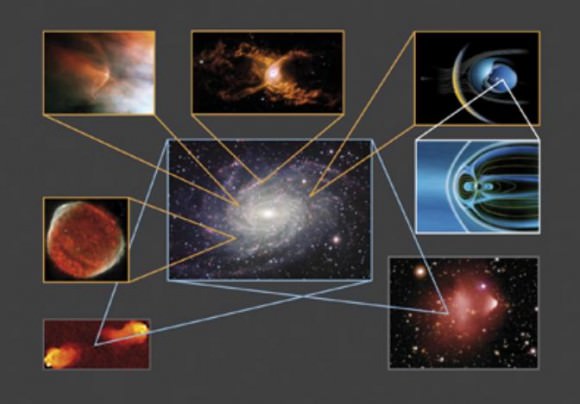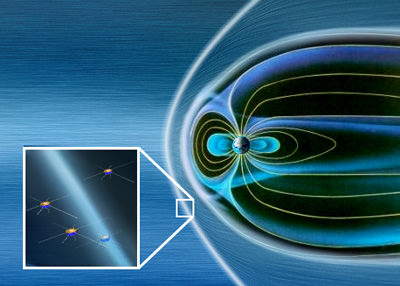
Depicted in the composition are: a bow shock around the very young star, LL Ori, in the Great Orion Nebula (upper row, left image); shock waves around the Red Spider Nebula, a warm planetary nebula (upper row, central image); very thin shocks on the edge of the expanding supernova remnant SN 1006 (central row, left image); artist's impressions of the bow shock created by the Solar System as it moves through the interstellar medium of the Milky Way (upper row, right image) and of Earth's bow shock, formed by the solar wind as it encounters our planet's magnetic field (central row, right image); shock-heated shells of hot gas on the edge of the lobes of the radio galaxy Cygnus A (lower row, left image); a bow shock in the hot gas in the merging galaxy cluster 1E 0657-56, also known as the 'Bullet Cluster'.
Are you ready to dance with a new discovery? ESA’s Cluster satellites are playing the tune of cosmic particle acceleration – and it’s more efficient than speculated. Now we’re taking a look at the beginnings of universal motion. By embracing a wide variety of astronomical targetry, the images are revealing shock waves where supersonic flows of plasma encounter everything from a slow flow to an irresistible force.
What sets things in motion? When it comes to particle accelerators, something needs to set it off. Here on Earth, the Large Hadron Collider (LHC) located at Cern uses a bank of smaller machines for giving rise to the charged particles before introducing them into the mainstream. In space, cosmic rays act as this “mainstream”, but they aren’t very efficient at setting the particles going initially. Now the ESA Cluster mission has revealed what could be ” natural particle accelerators of space”.
While cruising through a magnetic shock wave, the four Cluster satellites found themselves perfectly lined up with the magnetic field. This perfect chance alignment was a revelation – allowing the mission to sample the event with incredible accuracy on a very short timescale – one of 250 milliseconds or less. What surfaced from the investigation was the realization that the electrons heated rapidly, a state which contributes to acceleration on a greater scale. While this type of action had been speculated before, it hadn’t been observed or proved. No one really knew about the process or the size of the shock layers. With this new data, Steven J. Schwartz of the Imperial College London, and his colleagues were able to estimate the thickness of the shock layer – a significant advancement in understanding, because a thinner layer means faster acceleration.
“With these observations, we found that the shock layer is about as thin as it can possibly be,” says Professor Schwartz.
So just how skinny is this dance partner? Scientists had originally estimated the shock layers above Earth to be no more than 100 km, but the satellite information showed them to be about 17 km… a very fine detail!

Artist's impression of the four Cluster spacecraft flying through the thin layer of Earth's bow shock. The crossing, which took place on 9 January 2005, showed that the shock's width was only about 17 kilometres across.
This type of knowledge is significant simply because shocks exists universally – originating virtually everywhere a flow encounters an obstacle or another flow. For example, here in the Solar System the Sun generates a speedy, electrically charged stellar wind. When it runs headlong into a magnetic field – such as generated by Earth – it creates a shock wave located in front of the planet. Through the Cluster mission studies, we can apply what we learn here at home and extrapolate it on a grander scale – such as those created by supernovae events, black holes and galaxies. It might even reveal the origin of cosmic rays!
“This new result reveals the size of the proverbial ‘black box’, constraining the possible mechanisms within it involved in accelerating particles,” says Matt Taylor, ESA Cluster project scientist. “Yet again, Cluster has provided us with a clear insight into a physical process that occurs throughout the Universe.”
Come on, baby. Let’s dance…
Original Story Source: ESA News Release.
Source: Universe Today
No hay comentarios:
Publicar un comentario